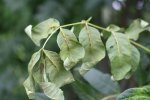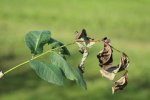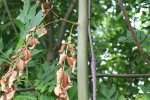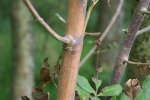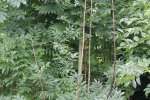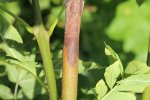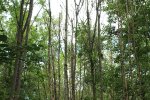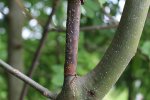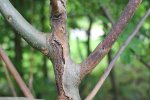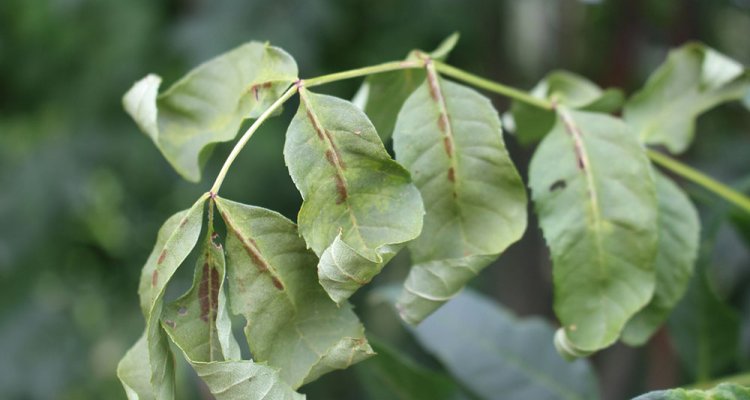
10 questions about ash dieback
Ash dieback affects both young and mature trees and is a rapidly growing problem. It’s caused by the fungus Hymenoscyphus fraxineus, also known as Chalara fraxinea. Ash dieback is found all over the Netherlands.
1.What causes ash dieback?
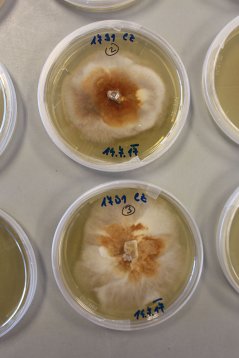
Ash dieback is caused by a fungus that originates from Asia, called Hymenoscyphus fraxineus.The fungus is also often still referred to by its old name: Chalara fraxinea. H. fraxineusis an invasive exotic species and is closely related to the native Hymenoscyphus albidus, a species of fungus that lives as a saprophyte on fallen ash leaf stalks.
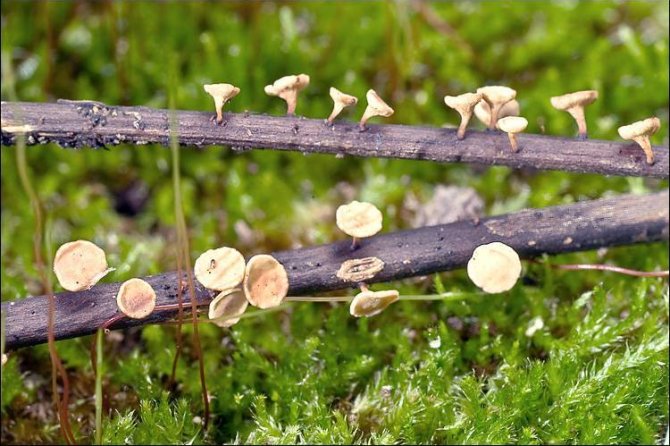
2. How is ash dieback identified?
H. fraxineusfungus infects trees through the leaves. The first symptoms are leaf spots, followed by discolouration of the veins and partial or complete death of the infected leaf. If the infestation persists, the fungus grows through the leaf stem into the twigs, where the bark and cambium are also affected. This leads to disruption of the sap flow, which becomes evident through the presence of withered leaves in the crown of affected ash trees during the growing season, as well as dead twigs and even dead parts of the crown. Other typical signs are the presence of elongated dead spots in the bark near the base of infected twigs, and the characteristic brown colour of dead twigs.
Click the images above to see the various symptoms.
3. Are all ash trees susceptible to ash dieback?
No. While most ash species are susceptible or even highly susceptible, there are also species that are less prone to the disease. The common ash (Fraxinus excelsior) is highly susceptible to ash dieback. Research has shown that there is also a lot of variation between individual trees within the species, with both seedlings and cultivars of common ash differing in terms of their susceptibility. But unfortunately, as far as we know, none of the known cultivars are completely resistant to the disease.
At the species level, the Manna ash (F. ornus) and Manchurian ash (F. mandshurica) are barely affected, and the American ash (F. americana) and Green ash (F. pennsylvanica) are thought to be less susceptible than the common ash. The Black ash (F. nigra) and narrow-leaved ash (F. angustifolia) on the other hand are considered to be highly susceptible, like the common ash.
4. Does ash dieback kill the trees?
Generally, the branches of affected trees gradually die so that as time goes on, more and more of the tree dies off. Meanwhile, older trees in particular continue to show signs of regrowth in those parts of the tree that are still alive and healthy. This means that older trees can survive for several years and sometimes recover, either fully or partially. Younger trees and coppice shoots are more likely to die. Trees in urban environments seem to be somewhat less frequently and severely affected than trees in forests and closed plantations, and particularly those in coppiced areas.
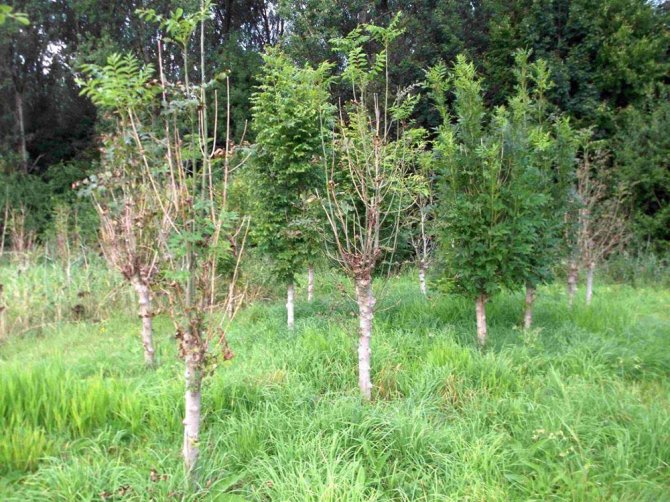
5. Is there a treatment that can cure the trees?
There are no methods available to protect trees in urban green spaces and rural landscapes from ash dieback. There is also no treatment that can cure affected trees. Pruning away heavily damaged parts helps to reduce the danger of falling branches and encourages regrowth from any remaining healthy parts of the tree, but is certainly no guarantee that the disease won’t persist. New infections can also appear at any time. Removing fallen leaves reduces the rate of infection, but spores can also be blown in on the wind from elsewhere, so this too cannot be guaranteed to prevent new infections.
6. Is ash dieback only found in the Netherlands?
No, the disease is now prevalent across Europe. The first reports date back to the 1990s when the disease was observed in Poland and the Baltic countries. It then steadily spread further across Europe. It has been present in the Netherlands since at least 2010 but its spread has grown significantly in recent years. In German-speaking countries, it’s known as Eschentriebsterben or Eschenwelke. Ash dieback is also sometimes referred to as Chalara disease.
7. How does ash dieback spread?
Between June and September, the fungus forms small, white mushrooms on leaf stems that have fallen off infected trees. These mushrooms produce large numbers of spores that can be dispersed across large distances by the wind. The spores can lead to new infections in the leaves of otherwise healthy trees, after which the cycle starts all over again. The disease can also be spread by plants that have been infected but don’t yet have any symptoms.
8. Is research being done into ash dieback?
Absolutely. A number of European countries have been conducting research into ash dieback for quite some time. Initially, this research focused on finding the cause and mapping the spread of the disease. Now it’s focused more on the disease process and on finding sources of resistance. Most of the research is focused on ash trees in forests. Studies in Denmark, Germany and the Netherlands have shown that 1-2% of trees among seedling populations of F. excelsiorare are much less susceptible.
Within the Netherlands, Wageningen University & Research (WUR) has been conducting research into ash dieback for several years now, with a focus both on trees in the forestry sector (CGN: the Centre for Genetic Resources Netherlands) and trees in urban green spaces and rural landscapes. From 2015 till 2019, WUR has been working in partnership with the private sector to test all ash species and cultivars used in urban green spaces and other landscapes, with funding from the EU and Top Sector Horticulture and Starting Materials (T&U). The objective was on the one hand to identify the risks to existing trees in the Netherlands, and on the other to identify those species or cultivars that could replace our existing, highly susceptible ash trees, in both urban and rural landscapes. This research combined traditional infectious disease trials with DNA analyses. A summary of the results can be found here.
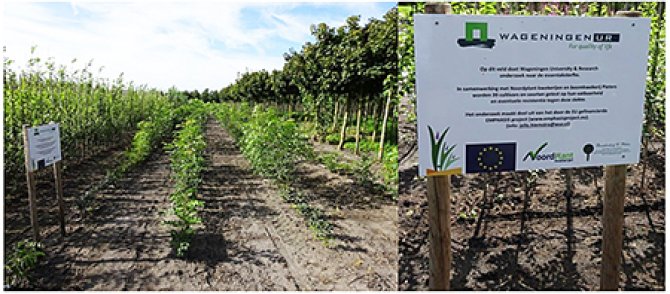
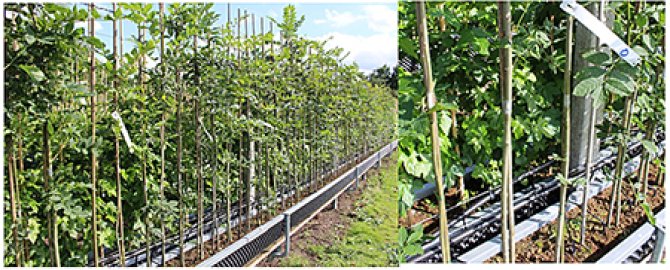
As part of a second line of research, the CGN is working on the conservation of the native common ash (Fraxinus excelsior) for forests and rural landscapes in particular. In the summer of 2017, there was a public appeal for people to report any remaining healthy ash trees within heavily infected areas on Essentaksterfte.nu. The CGN aims to identify a large pool of resilient trees to ensure the safeguarding of genetic diversity. Samples from those ash trees will be used to propagate them and to study why the fungus has little impact on them. The study will also examine whether healthy ash trees also produce a lot of healthy descendants, so that eventually a new source of seeds could be established and help create a new, healthy population.
9. What can environmental managers do?
As mentioned above, there is no treatment that can cure the tree. Moreover, larger trees in areas with low rates of infection, such as in urban areas, aren’t being rapidly killed off. The recommendation, therefore, is to exercise a high degree of restraint and to leave healthy trees alone. Large, dead branches can be pruned, especially if they pose a hazard. However, there’s not much point in pruning away all the dead wood, because new infections can take hold through the leaves every year.
It’s also not much use removing all affected trees. If it poses no hazard, an affected tree can be left alone and time will tell whether it’s able to stop the spread of the disease by itself. Unfortunately, in forests with high rates of infection it’s often necessary to intervene, especially along footpaths and roads, but even there the advice is to leave healthy trees in place, as they have an important role in the survival of the species. Incidentally, no special rules apply to the disposal of the wood of diseased trees. Unlike wood from diseased elms, wood from diseased ash trees is not a source of infection, nor are ash bark beetles involved in spreading the fungus that causes ash dieback.
In urban areas, clearing fallen leaves can help reduce the rate of infection, but it’s never going to be entirely effective because the spores are spread over long distances through the air. The best long-term solution is to use resistant seedlings to replace susceptible species. This is something the research is currently focusing on.
It’s important to monitor the condition of ash trees in urban areas and along roads so that we have a good idea of how badly they’re affected and in particular so we can determine whether interventions are necessary to limit the associated risks. WUR has drawn up a protocol for this, in partnership with specialists in the field. This protocol standardises the recording of ash dieback in urban and rural settings, thereby providing a more complete and reliable picture of the severity and development of the disease. Based on this, we can then implement targeted interventions. The report and the protocol for monitoring are available online (see publications).
10. Why is it important to protect ash trees?
The common ash (Fraxinus excelsior) is native to the Netherlands and plays a vital role in biodiversity: around 100 species of plants, mosses and insects depend specifically on the ash tree. The ash has also traditionally been highly valued for its many uses. The wood is strong and resilient and is used to make handles for tools (and was historically used to make spears). It’s also used for sports equipment such as gymnastics bars, hockey sticks and canes, and in the past was used to make skis. It’s used for furniture and veneer, and is highly valued as firewood. The foliage was also used for cattle feed in the past. All of these qualities mean that the ash is a characteristic feature within the cultural landscape of north-west Europe.
In the Netherlands, the tree has an important place in both urban and rural settings, and in the rich soils of forests. In urban areas, around 10 cultivars of common ash and some other ash species are widely used to line streets and avenues. In terms of forestry, the common ash is the most important species of deciduous tree after oak, beech and poplar. It’s also widely used for landscape planting schemes and in recreational areas.

